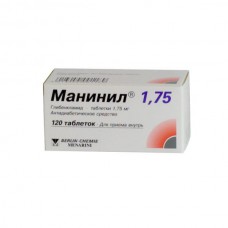Expiration date: 05/2026
Structure and Composition:
Maninil 1.75
One tablet contains micronized glibenclamide 1.75 mg
Excipients: lactose monohydrate, potato starch methylhydroxyethylcellulose stearate silicon dioxide colloidal magnesium cochineal red A (coloring agent E124)
glass vials for 120 pcs. In the paper cartons 1 bottle or blister pack of 10 or 20 pieces. In the paper cartons 3 blisters.
Maninil 3.5
One tablet contains micronized glibenclamide 3.5 mg
Excipients: lactose monohydrate, potato starch methylhydroxyethylcellulose stearate silicon dioxide colloidal magnesium cochineal red A (coloring agent E124)
glass vials for 120 pcs. In the paper cartons 1 bottle or blister pack of 10 or 20 pieces. In the paper cartons 3 blisters.
Maninil 5
One tablet contains glibenclamide 5 mg
Excipients: lactose monohydrate, magnesium stearate, potato starch, talc, gelatin, cochineal red A (coloring agent E124)
glass vials for 120 pcs. In the paper cartons 1 vial or in blister 20 pcs. In the paper cartons 1, 2, 3, 4 or 6 blisters.
Description pharmaceutical form:
Tablets of 1.75 and 3.5 mg: round, flat on both sides, pink, with beveled edges and a one-sided risk of division.
Tablets 5 mg: Round, flat on both sides, from pale pink to pink, with beveled edges and a notch for division.
Characteristic:
Derivative II generation sulfonylureas.
Micronized Maninil - a high-tech form of specially milled glibenclamide for optimal pharmacokinetic and pharmacodynamic profile.
Pharmachologic effect:
It has pancreatic and extrapancreatic effects. Pancreatic activity is manifested in the stimulation of insulin secretion of pancreatic beta-cells, extrapancreatic - to increase the sensitivity of insulin receptors of target tissues (due to stimulation of the tyrosine kinase), insulin, suppression of gluconeogenesis and glycogenolysis in the liver.
Pharmacokinetics:
Quickly (by micronisation) is absorbed in the digestive tract, which allows you to take just before eating. Bioavailability - 100% in micronized form.
Binding to plasma proteins - 95%. T1 / 2 - 3-10 hours duration of action -.. More than 12 hours in liver biotransformed to inactive metabolites. Excreted by the kidneys (50%) and liver (50%). Cumulation absent.
The rate of absorption of micronized Maninil above, it dissolves quickly and is delivered to the body tissues.
Description of the pharmacological actions:
It reduces the risk of developing complications of insulin-dependent diabetes mellitus (vascular, retinopathy, nephropathy, cardiomyopathy) and mortality associated with diabetes.
It has cardioprotective and antiarrhythmic effect, reduces platelet aggregation
Clinical Pharmacology:
Micronized form provides an earlier attainment of Cmax, hypoglycemic effect line practically corresponds to a peak postprandial hyperglycemia, which provides its physiologic effect in combination with short T1 / 2, reduces the risk of hypoglycemia. Daily demand for glibenclamide can be reduced by 30-40%.
Testimony:
Diabetes mellitus type 2 (insulin-independent) with poor diet, weight loss and obesity sufficient physical activity.
Contraindications:
Hypersensitivity (including to sulfanilamides and other derivatives sulfonylureas), diabetes mellitus type 1 (insulin-dependent), metabolic decompensation (ketoacidosis, precoma, coma), state after resection of the pancreas, severe liver and kidney disease, some acute conditions (eg, decompensation of carbohydrate metabolism in infectious diseases, burns, trauma or after major surgery, when shown holding insulin), leukopenia, ileus, gastroparesis, a condition accompanied by malabsorption of food and the development of hypoglycemia, pregnancy and lactation.
Application of pregnancy and breastfeeding:
Contraindicated during pregnancy. At the time of treatment should stop breastfeeding.
Side effect:
Possible hypoglycemia (when skipping meals, drug overdose, while the amplified physical activities, as well as intensive use of alcohol).
From the digestive tract: sometimes - nausea, vomiting in some cases - cholestatic jaundice, hepatitis.
Hematopoietic system: rarely - thrombocytopenia, granulocytopenia, erythropenia (up to pancytopenia), in some cases - hemolytic anemia.
Allergic reactions: seldom - skin rash, fever, joint pain, proteinuria.
Other: at the beginning of treatment may upset transient accommodation. In rare cases - photosensitivity.
Drug Interactions:
Effect increase of ACE inhibitors, anabolic steroids, beta-blockers, fibrates, biguanides, chloramphenicol, cimetidine, coumarin derivatives, some anticancer drugs, pentoxifylline, phenylbutazone, reserpine, salicylates, sulfonamides, tetracyclines weakening - acetazolamide, barbiturates, chlorpromazine, glucocorticoids, glucagon, hormonal contraceptives, phenothiazines, phenytoin, saluretiki, thyroid hormones. Together with the admission of alcohol might as strengthening and weakening of the hypoglycemic action.
Dosage and administration:
Inside, in the morning and evening, before meals, without chewing. The dosage is determined individually depending on the severity of the disease.
Maninil 1.75
Initial dose - 1/2 Table, average -. Table 2. per day, the maximum - 3, in exceptional cases - see Table 4. per day. If you want to receive higher doses (up to 14 mg / day) moving to Maninil 3.5 mg.
Maninil 3.5
The initial dose - 1 / 2-1 Table average -. Table 1. per day, the maximum - 3, in exceptional cases - see Table 4. per day. Daily doses of up to 2 tablets. usually take one (morning), higher - divided into 2 doses (morning and evening).
Maninil 5
Initial dose - 1/2 Table, average -. Table 2. per day, maximum - Table 3-4. per day.
Three dosage forms allow the use of 20 potential dosing regimens.
Overdose:
Symptoms of hypoglycemia (acute hunger, sweating, feeling tremors, palpitations, agitation, headache, sleep disturbance).
Treatment: Ingestion of sugar or carbohydrate (in mild cases), in / in the introduction - 40-80 ml of 40% glucose solution, and then in / infusion - 5-10% glucose solution (in severe cases) in / m or m / K - 2.1 mg of glucagon.
Precautionary measures:
To use caution in febrile syndrome, thyroid disease (with impaired function), hypofunction of the anterior pituitary or the adrenal cortex, alcoholism, in elderly patients because of the likelihood of hypoglycemia. Requires regular medical supervision. In the treatment should strictly follow a diet. Admission Maninil does not replace diet. During treatment is not recommended to engage in activities requiring concentration of attention and speed of psychomotor reactions, long-term stay in the sun. Need dosage adjustment in the physical and emotional strain, a change of diet.




